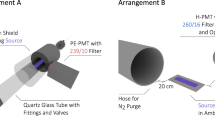Abstract
Remote detection of alpha radiation by optical means is a widely accepted alternative to the more traditional detection methods that typically rely on direct contact with the radiation itself. Optical detection operates by collecting the light, the radioluminescence that is produced when alpha particles are being stopped in a medium. Each medium creates radioluminescence with a distinct spectral pattern and intensity. To properly design the detection optics, the radioluminescence’s spectral shape and the number of photons generated per alpha event have to be known. Those properties are well known for some stopping media like air, and remote detection has been successfully implemented. However, the radioluminescence properties for the stopping media nitric acid and water are not well known, which prevents the application of the technique in relevant areas like spent nuclear fuel processing. In this contribution, we determine the light yield of alpha particles emitted by 241Am dissolved in a well characterized weak nitric acid solution. It was found to be 0.31 ± 0.007 photons per alpha event.








Similar content being viewed by others
References
Geiger H, Nuttall JM (1911) The ranges of the α particles from various radioactive substances and a relation between range and period of transformation. London Edinb Dublin Philos Mag J Sci 22:613–621
Rutherford E, Geiger H (1908) An electrical method of counting the number of α-particles from radioactive substances. Proc Royal Soc London Series A Math Phys Character 81:141–161
Shultis JK, Faw RE, Kase KR (1996) Radiation shielding. Prentice Hall PTR Upper Saddle River, New Jersey
Pineau J-F, Imbard G (2001) Remote α-source location device and method. US Patent 6, Aug. 2001, 281: 502
Sand J (2016) Alpha radiation detection via radioluminescence of air, PhD thesis. Tampere University of Technology: Tampere University of Technology, Sweden
Chilton AB, Shultis JK, Faw RE (1984) Principles of radiation shielding. Prentice-Hall Publishers, Englewood Cliffs, N.J.; London
Dondes S, Harteck P, Kunz C (1964) Production of the Oxygen 5577 A Emission by Polonium-210 Alpha Radiation. Zeitschrift für Natur-forschung A 19:6–12
Knoll GF (2010) Radiation detection and measurement. Wiley, Hoboken
Arqueros FJ, Hörandel R, Keilhauer B (2008) Air fluorescence relevant for cosmic ray detection: Summary of the 5th fluorescence workshop, El Escorial 2007, Nuclear Instruments and Methods in Physics Research Section A: Accelerators, Spectrometers, Detectors and Associated Equipment. 597: 1–22
Waldenmaier T, Blümer J, Klages H, Klepser S (2005) Measurement of the fluorescence yield in air with the Air Light experiment. In Shapiro MM, Stanev T, Wefel JP (eds) Neutrinos and Explosive Events in the Universe. Springer, 403–408
Kerst T, Toivonen J (2018) Intense radioluminescence of NO/N2−mixture in solar blind spectral region. Opt Express 26(26):33764–33771
Dondes S, Harteck P, Kunz C (1966) A spectroscopic study of alpha ray induced luminescence in gases: part. Radiat Res 27:174–210
Crompton A, Gama K, Bell S, Wilson AP, Jenkins AW, Trivedi D (2018) Gas flow to enhance the detection of alpha-induced air radioluminescence based on a UVTron flame sensor. Sensors 18(6):1842
Christensen H, Sunder S (2000) Current state of knowledge of water radiolysis effects on spent nuclear fuel corrosion. Nuclear Tech 131:102–123
Taylor R (2015) Reprocessing and recycling of spent nuclear fuel. Elsevier, Amsterdam
Yamamoto S, Komori M, Koyama S, Toshito T (2016) Luminescence imaging of water during alpha particle irradiation, nuclear instruments and methods in physics research section A: accelerators. Spectrom Detect Assoc Equip 819:6–13
Kerst T, Malmbeck R, Banik NL, Toivonen J (2019) Alpha radiation-induced luminescence by Am-241 in aqueous nitric acid solution. Sensors 197:1602
Yamamoto S, Akagi T, Kawachi N (2018) Source of luminescence of water lower energy than the Cerenkov-light threshold during irradiation of carbon-ion. J Phys Commun 2:065010
Banik NL, Lützenkirchen K, Malmbeck R, Nicholl A (2019) A method for the mg separation of Cm from Am using a SCX column. J Radioanal Nucl Chem 321:841–849
Sand J (2016) Alpha radiation detection via radioluminescence of air, PhD thesis. Tampere University of Technology: Tampere University of Technology, Sweden
Sand J, Ihantola S, Peräjärvi K, Toivonen H, Toivonen J (2014) Radioluminescence yield of alpha particles in air. New J Phys 16:053022
Shao MZ, Badler N (1996) Spherical Sampling by Archimides' Theorem; Technical Reports (CIS), Univ. of Pennsiylvania, http://repository.upenn.edu/cis_reports/184
NIST http://physics.nist.gov/PhysRefDate/Xcom/html/xcom1.html]]
Belcher EH (1953) The luminescence of irradiated transparent media and the Cerenkov effect. I. The luminescence of aqueous solutions of radioactive isotopes. Proc Royal Soc A 216:90–102
Tufan M Ç, Magill J, Gally J (2008) Range and stopping power calculation, NESTet—Education and Training—Nuclear Engineering Science and Tech., 221–225
Acknowledgements
The authors wish to especially thank Adrian Nicholl (JRC-Karlsruhe) for his constant support before, during and after the experiments. This work has partially received funding from the EMPIR programme MetroDECOM II (Grant No. 16ENV09) co-financed by the Participating States and from the European Union’s Horizon 2020 research and innovation programme. The work is part of the Academy of Finland Flagship Programme, Photonics Research and Innovation (PREIN), decision 320165. The experimental data used in this research were generated through access to the ActUsLab/PAMEC under the Framework of access to the Joint Research Centre Physical Research Infrastructures of the European Commission (" Remote detection of radioluminescence from alpha activity”, AUL-2017-20-207).
Author information
Authors and Affiliations
Corresponding author
Additional information
Publisher's Note
Springer Nature remains neutral with regard to jurisdictional claims in published maps and institutional affiliations.
Rights and permissions
About this article
Cite this article
Malmbeck, R., Banik, N.l., Kerst, T. et al. Photon yield of radioluminescense produced by 241Am in weak nitric acid solution. J Radioanal Nucl Chem 328, 869–878 (2021). https://doi.org/10.1007/s10967-021-07703-1
Received:
Accepted:
Published:
Issue Date:
DOI: https://doi.org/10.1007/s10967-021-07703-1




